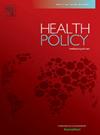Are long-term care systems aligned with person-centered integrated care? Evidence from the Western Pacific
IF 3.4
3区 医学
Q1 HEALTH CARE SCIENCES & SERVICES
引用次数: 0
Abstract
Background
Many Western Pacific countries have established long-term care (LTC) systems to support their rapidly aging populations. However, the extent to which these systems align with integrated care principles that enable individuals to age in place (AIP) remains unclear. Effective integration of LTC with healthcare is essential to enhance continuity of care, improve outcomes, and support AIP.
Objective
This study examines the alignment of LTC policies in five Western Pacific countries—Australia, Japan, New Zealand, Republic of Korea, and Singapore—with integrated LTC principles. The analysis identifies systemic enablers and challenges in governance, financing, workforce, service delivery, information, monitoring & evaluation (IM&E), and innovation & research.
Methods
Using an adapted World Health Organization LTC framework, we conducted a comparative analysis of the selected countries’ LTC policies.
Results
All five countries emphasize aging in place and provide both institutional and community-based LTC services. However, key enablers of integration are often lacking. Fragmentation between LTC and healthcare is common, and coordination mechanisms such as care planning are hindered by inadequate accountability mechanisms due to misaligned incentives, challenges in funding integration, and often underdeveloped information systems for monitoring integrated care.
Conclusion
Western Pacific LTC systems are not yet fully aligned with effective integrated LTC. Strengthening coordinated and accountable governance, integrating financing streams and incentive, enhancing IM&E systems for performance management, and leveraging innovation are crucial to enhancing integrated LTC in the region.
长期护理系统是否与以人为本的综合护理相一致?证据来自西太平洋。
背景:许多西太平洋国家已经建立了长期护理(LTC)系统,以支持其迅速老龄化的人口。然而,这些系统在多大程度上符合使个人能够就地养老的综合护理原则(AIP)仍不清楚。LTC与医疗保健的有效整合对于增强护理的连续性、改善结果和支持AIP至关重要。目的:本研究考察了五个西太平洋国家(澳大利亚、日本、新西兰、韩国和新加坡)的长期医疗服务政策与综合长期医疗服务原则的一致性。该分析确定了治理、融资、劳动力、服务提供、信息、监测与评估(IM&E)以及创新与研究方面的系统性推动因素和挑战。方法:采用改编的世界卫生组织长期医疗服务框架,我们对选定国家的长期医疗服务政策进行了比较分析。结果:所有五个国家都强调老龄化,并提供机构和社区LTC服务。然而,集成的关键促成因素通常是缺乏的。长期服务和医疗保健之间的碎片化很常见,由于激励措施不一致、资助整合方面的挑战以及监测整合护理的信息系统往往不发达,导致问责机制不足,从而阻碍了护理计划等协调机制。结论:西太平洋LTC系统尚未完全与有效的综合LTC保持一致。加强协调和负责任的治理,整合融资渠道和激励机制,加强绩效管理的IM&E系统,利用创新,对于加强本地区的综合长期合作至关重要。
本文章由计算机程序翻译,如有差异,请以英文原文为准。
求助全文
约1分钟内获得全文
求助全文
来源期刊

Health Policy
医学-卫生保健
CiteScore
6.40
自引率
6.10%
发文量
157
审稿时长
3-8 weeks
期刊介绍:
Health Policy is intended to be a vehicle for the exploration and discussion of health policy and health system issues and is aimed in particular at enhancing communication between health policy and system researchers, legislators, decision-makers and professionals concerned with developing, implementing, and analysing health policy, health systems and health care reforms, primarily in high-income countries outside the U.S.A.
 求助内容:
求助内容: 应助结果提醒方式:
应助结果提醒方式:


